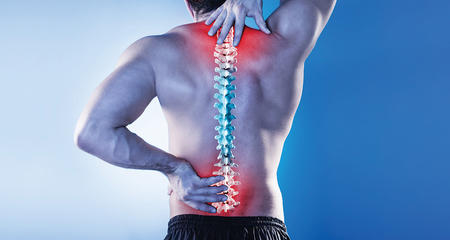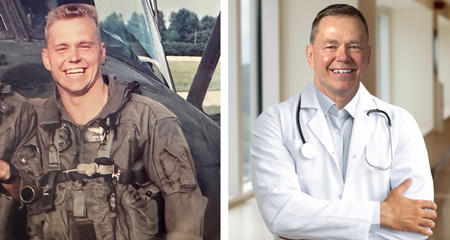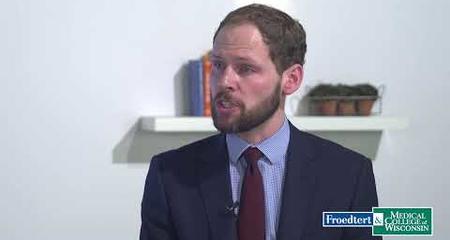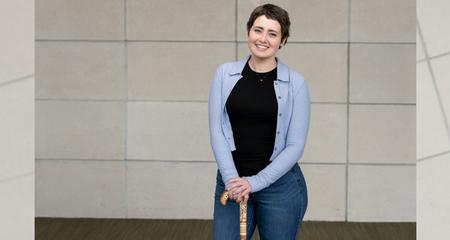Orthopaedic problems cover a wide spectrum of disorders, conditions and injuries related to the musculoskeletal system, including bones, joints, muscles, tendons and ligaments. Froedtert & the Medical College of Wisconsin is a national leader in the treatment and understanding of all types of orthopaedic conditions.
Learn more about orthopaedic conditions in these specialty areas:
- Back and Neck Care (spinal disorders)
- Bone and Connective Tissue Cancer (sarcoma)
- Hand and Upper Extremity Services
- Joint Replacement and Reconstruction (hip, knee and other joints)
- Metastatic Bone Disease
- Sports Medicine
- Trauma
Or, use this alphabetical list to locate a condition to learn more.
-
Achilles tendon injuries
The Achilles tendon is the band of tissue that connects the calf muscle to the heel bone. The Achilles tendon can be injured, inflamed, damaged or torn in a variety of ways. Minor problems with the Achilles tendon may be treated non-surgically, with rest, medication or therapy. In severe cases, however, surgery is required to repair the Achilles tendon.
-
ACL (anterior cruciate ligament)
The ACL is one of four knee ligaments and the most common knee ligament to be injured. Female athletes are more prone to ACL injuries than males. Treatment for an ACL injury depends on several factors and can include medication, therapy and bracing. Surgery may also be an option to repair an ACL. Learn more about our ACL Injury Prevention Program.
-
Flat feet (adult-acquired flatfoot disorder AAFD)
A flatfoot disorder refers to the collapse of the foot’s arch. The most common cause is posterior tibial tendon dysfunction (PTTD), where the posterior tibial tendon becomes inflamed or torn. The tendon is then less able to stabilize and support the arch. AAFD can be treated with orthotics and braces. In some cases, however, surgery is needed to repair the condition. Learn more about our Foot and Ankle Program.
-
Ankle arthritis
Ankle arthritis is joint inflammation that affects the ankle. It can have many causes, and can be treated non-surgically. However, if other treatments fail and pain persists, several surgical options may be considered, including ankle replacement.
-
Arthritis
Arthritis is a chronic disease of the joints. Inflammation causes pain and swelling, often making it difficult to move the affected joint(s). There are several types of arthritis, and three common types are osteoarthritis, rheumatoid arthritis and post-traumatic arthritis. A range of treatment options is available for patients with arthritis.
-
Avascular necrosis (bone death)
Avascular necrosis, also called osteonecrosis, aseptic necrosis or ischemic bone necrosis, occurs when the bone’s blood supply is cut off temporarily or permanently. This leads to bone death, and can be caused by injury, trauma, some cancer treatments, long-term use of some medications or excessive alcohol use. Avascular necrosis can affect the joints, and non-surgical treatments are possible. However, joint replacement may be necessary for some patients with avascular necrosis.
-
Back injuries
Back injuries, whether old or new, require expert care to find the best treatment approach. We offer advanced treatment options for back injuries.
-
Back pain
Back pain can have many causes, from injury and trauma to disease, infection, tumor, obesity and more. Back pain, whether acute or chronic, can be disabling. Our multidisciplinary orthopaedics team diagnoses and treats the entire spectrum of conditions that can cause back pain, offering both non-surgical and surgical back pain treatment options.
-
Bone and connective tissues tumors
Also called musculoskeletal tumors, bone and connective tissue tumors may be benign or malignant and occur in the bones, joints, ligaments, tendons, nerves or muscles.
-
Bone and connective tissue cancer (sarcoma)
Musculoskeletal oncologists and other specialists in our Bone and Connective Tissue (Sarcoma) Cancer program offer advanced, comprehensive care for all types of musculoskeletal cancer.
-
Brachial plexus injury
The brachial plexus is the network of nerves that control the signals from the spine to the shoulders, arms and hands. Our experts evaluate and treat this condition in our Brachial Plexus Clinic.
-
Bunions (hallux valgus)
A bunion is a protrusion or bony bump that occurs around the joint at the base of the big toe (hallux). Bunions can be caused by flat feet, heredity, or too-tight shoes, among other causes, that put prolonged stress on the joint. Bunions can be treated non-surgically. However, some patients may require surgical treatment. Learn more about our Foot and Ankle Program.
-
Cervical spine disc problems
Cervical spine disorders can affect the neck and arms, and may include injuries of the muscles and ligaments, degenerative diseases like arthritis, and compression of the spinal cord. Experts in our Back and Neck program diagnose and treat all types of spine disorders.
-
Concussion
A concussion is a form of traumatic brain injury and requires medical attention. Learn more about our Concussion Clinic.
-
Congenital birth disorders
A congenital disorder exists at birth, and can include structural limb deformities. Depending on the nature and extent of the congenital disorder, surgical options may be available.
-
Degenerative disc disease
Often a normal byproduct of aging, degenerative disc disease can cause back or neck pain and other symptoms. It can also lead to osteoarthritis, disc herniation and other conditions. Learn more at our Back and Neck program.
-
Dislocations/complex instability
Dislocations, when a joint is out of normal alignment, can affect any joint, but often occur in the shoulder, elbow, and knee. Dislocations may be treated by manually moving the joint back into place and with medications and therapy. Dislocations and other injuries can make the joint unstable. In some cases, surgery may be required to repair dislocations and/or joints that have become unstable.
-
Fractures
A fracture is a break in the bone. Fractures may be minor, such as a hairline fracture, or severe, such as a compound fracture, where the bone may protrude through the skin. Stress fractures often occur due to injury or overuse.
-
Hallux rigidus (stiff big toe)
Arthritis, injury, bone spur or other factors can affect the metatarsophalangeal (MTP) joint of the big toe (hallux), preventing it from bending properly when you walk. Learn more about treatments for this and other Foot and Ankle conditions.
-
Herniated disc, cervical (neck) or lumbar (back)
Herniated discs have deteriorated to the point that they bulge out or rupture, causing pain. Orthopaedic specialists in our Back and Neck program provide specialized care for herniated discs.
-
Hip dysplasia
Hip dysplasia, sometimes called hip dislocation or developmental dysplasia of the hip (DDH), means that the hip joint is the wrong shape or the hip socket is not in the proper position to cover the femoral head (ball). In some cases, hip preservation or hip replacement may be necessary.
-
Hip pain
Hip pain has multiple causes, including osteoarthritis, injury, impingement (femoroacetabular impingement, FAI), infections and deformities. When other treatment options have failed and pain makes everyday activities difficult, hip preservation or hip replacement may be an option.
-
Knee pain
Painful knees may be the result of arthritis, injury, overuse and many other causes. If cartilage becomes so damaged or tissues around the joint so inflamed that walking, climbing stairs, sitting or even sleeping are painful, knee replacement might be recommended.
-
Labral tears (hip or shoulder)
The labrum is a fibrous ring of cartilage found in the hip and shoulder, which are both ball-and-socket joints. An injury to the labrum or labral tear in either the hip or shoulder may be treated with physical therapy or medications. However some labral tears may require surgical repair depending on the type and severity of the tear. A labral tear in the shoulder or the hip may be repaired with arthroscopic surgery.
-
Leg length discrepancy
Leg length discrepancy, where one leg is longer than the other, can have several causes, including a congenital birth disorder or injury. Depending on the difference in length, non-surgical treatment may include shoe lifts.
-
Malunions
Malunions are bone fractures that have healed improperly and generally require surgical repair.
-
Meniscal tears
Tears or injury to the meniscus, a cartilage in the knee joint, are one of the most common athletic injuries. Meniscal tears can also be caused by degenerative disease, or the thinning and wearing down of the meniscus due to age. Our orthopaedic specialists offer innovative treatments for meniscal tears, including our Cartilage Restoration and Meniscus Transplant Program.
-
Metastatic bone disease
Cancer that has spread to the bone from another location in the body is considered metastatic bone disease. Cancers that most commonly spread to the bone are breast, lung, prostate, kidney and thyroid. Learn more about our Bone and Connective Tissue (Sarcoma) Cancer program.
-
Morton's neuroma
A buildup or thickening of benign tissue that surrounds the nerves leading to the toes is called Morton's neuroma. Learn more about foot and ankle conditions and treatments.
-
Myelopathy, cervical (neck) myelopathy
Spinal cord compression that can cause weakness and other symptoms in the arms, hands, legs and feet. Our Back and Neck program treats all types of myelopathy.
-
Neck pain
An accurate diagnosis is the first step in treating neck pain, which can have a number of causes. There are many treatment options available through our Back and Neck program.
-
Nerve pain
Many orthopaedic conditions can affect nerves, causing pain, numbness, tingling and other symptoms.
-
Nonunions (unhealed fractures)
Nonunions, or fractures that have not healed properly, generally require surgical care.
-
Orthopaedic infections
Orthopaedic infections can be serious and require prompt, thorough attention. Treatments vary and may include medications, including antibiotics, or surgical treatments, if necessary. Our orthopaedic experts are trained in preventing, treating and managing all types of orthopaedic infections. In severe cases, our orthopaedic surgeons are skilled at limb-salvage and limb-sparing surgical techniques for the treatment of orthopaedic infections.
-
Osteoarthritis
A common form of chronic arthritis that affects the joints, especially the knees, hip, hands or spine. It is caused by the breakdown of cartilage in the joint. Several treatment options exist for osteoarthritis, including exercise, medications, physical therapy and other non-surgical treatments. In some cases, joint surgery may be necessary.
-
Osteoporosis
A common condition, osteoporosis or porous bone, leads to low bone mass and destruction of bone tissue. Weakened bones are much more likely to fracture, even as the result of everyday activities or without major trauma. Our Bone Health Clinic works with patients after a fracture to prevent additional fractures. Female athletes also have unique needs, and preventing osteoporosis is a key facet of our Women’s Sports Medicine Program.
-
Post-traumatic orthopaedic infection (Osteomyelitis)
Infections that occur after an orthopaedic trauma need special care.
-
Radiculopathy, cervical (neck) or lumbar (back)
A disorder of the nerve root that impairs nerve function. Lumbar radiculopathy is also known as sciatica. We treat radiculopathy and other back and neck conditions through our Back and Neck program.
-
Range of motion
Range of motion refers to how much a joint can flex and extend. Range of motion may be restricted due to injury, surgery or other causes. Our rehab and therapy experts help patients improve their range of motion regardless of the cause.
-
Rotator cuff injuries
The rotator cuff refers to the muscles and tendons that connect your arm to your shoulder. The rotator cuff helps lift and rotate the arm and holds the ball of the upper arm bone in the shoulder socket. Injury, overuse, wear and tear, or other damage to the rotator cuff can cause pain even with simple activities. Learn more about rotator cuff repair.
-
Sciatica (lumbar radiculopathy)
Sciatica is pain that originates along the primary nerve of the leg, called the sciatic nerve. Learn more about sciatica and related conditions through our Back and Neck program.
-
Scoliosis
Scoliosis is a degenerative condition that causes curvature of the spine. Our Back and Neck program offers expert diagnosis and treatment for scoliosis and other conditions.
-
Spinal fractures
Fractures of the spine can be caused by trauma, or by other conditions that weaken the vertebrae. Our Back and Neck program offers advanced treatments for spinal fractures and other conditions.
-
Spinal infections
Spinal infections require advanced care and may be treated surgically or non-surgically, depending on the nature and severity of the infection. Our Back and Neck program provides expert care for spinal infections and other serious conditions.
-
Spinal stenosis, cervical (neck) or lumbar (back)
Often age-related, stenosis is a narrowing of the open spaces in the spinal column. It can cause pain, numbness, muscle weakness and other symptoms. Learn more about our Back and Neck program.
-
Spinal tumors
Spinal tumors can occur in any section of the spine or spinal column. Primary tumors are those that originate in the spine; metastatic tumors are those that spread from elsewhere in the body. Learn more about treatment options for spinal tumors through our Bone and Connective Tissue Cancer (Sarcoma) program.
-
Spondylolysis
Spondylolysis is a crack, weakness or stress fracture in the connection between vertebrae. It is one of the most common causes of low back pain and gets worse with activity. Learn more about spondylolysis treatments offered by our Back and Neck program.
-
Spondylolisthesis
Related to spondylolysis, spondylolisthesis occurs when weakened vertebrae start to slip out of place. Learn more about surgical and non-surgical treatments offered by our Back and Neck program.
-
Tendonitis
Tendonitis is inflammation of the tendons, the flexible, fibrous cords of tissue that connect muscles to bones. Usually due to overuse, tendonitis often affects the shoulder, wrist, elbow, knee and ankle.
-
Tennis elbow (lateral epicondylitis)
Tennis elbow refers to pain on the outside of the elbow, usually caused by repetitive stress or overuse. Learn more about our Hand and Upper Extremity Services.
-
Trauma
Orthopaedic trauma can result from accidents, injury or overuse. Our orthopaedic trauma experts are part of multidisciplinary team working in our Trauma Center, the only adult Level I Trauma Center in eastern Wisconsin.
-
Work-related injuries
Work-related injuries require expert care to get patients safely and quickly back to work, everyday activities and normal function. We diagnose and treat all types of work-related injuries, providing treatment and rehab and therapy services tailored to each patient.
Virtual Visits Are Available
Safe and convenient virtual visits by video let you get the care you need via a mobile device, tablet or computer wherever you are. We'll assess your condition and develop a treatment plan right away. To schedule a virtual visit, call 414-777-7700.




